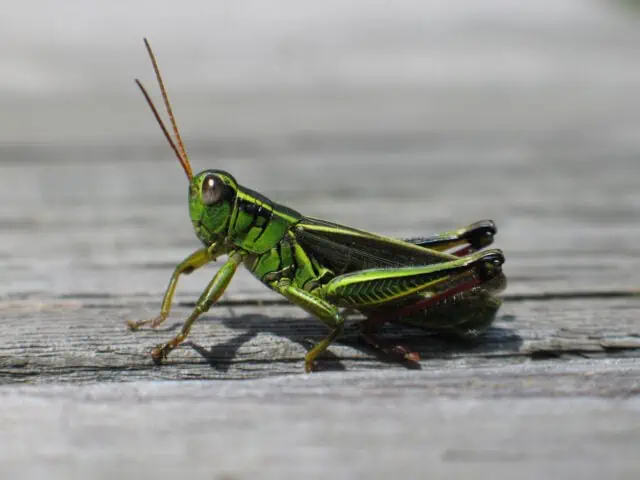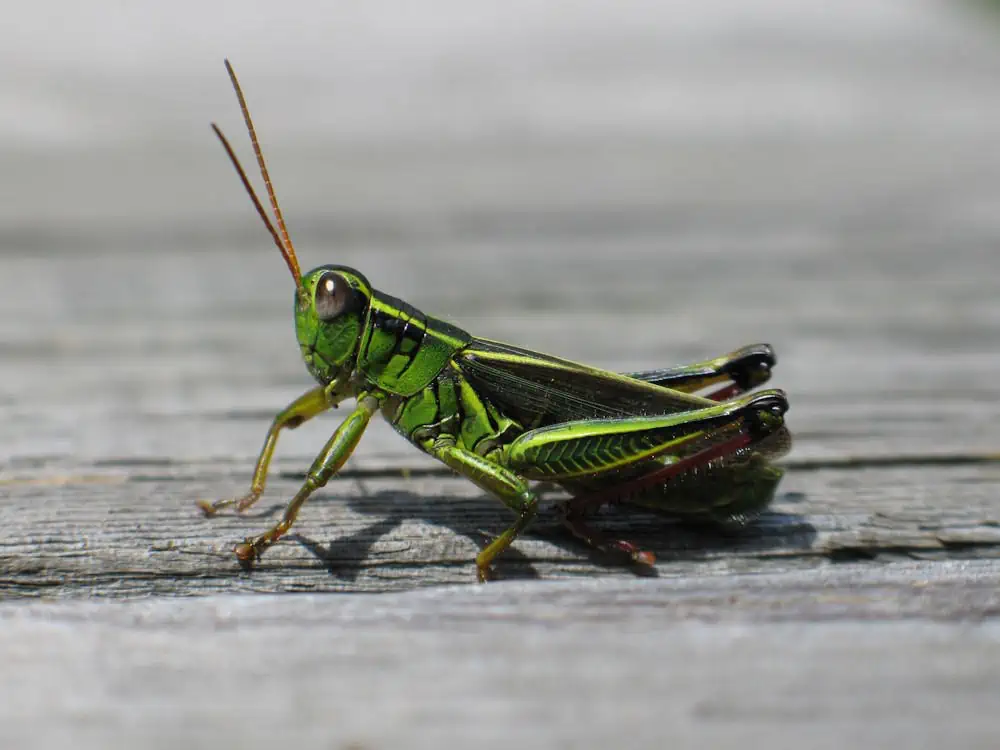Yes, leopard geckos can eat grasshoppers. These insects are among the variety of prey items that leopard geckos can consume. Grasshoppers, when sourced correctly and prepared appropriately, can offer valuable nutritional benefits to leopard geckos.
Can Leopard Geckos Eat Grasshoppers?
Absolutely, leopard geckos can indeed eat grasshoppers. Grasshoppers are not only palatable for these geckos but also provide a rich source of essential nutrients that contribute to their overall health. As with any dietary addition, though, there are certain considerations and precautions to keep in mind.
The Nutritional Value of Grasshoppers
When it comes to the dietary needs of leopard geckos, the nutritional value of the food they consume plays a pivotal role in their overall health.
Grasshoppers stand out as a noteworthy option due to their impressive protein content, making them a robust source of energy and muscle-building nutrients for the geckos.
Moreover, they offer a beneficial calcium to phosphate ratio, crucial for bone health and preventing conditions like metabolic bone disease in reptiles.
Comparatively, while crickets and mealworms are also popular choices for feeder insects, grasshoppers have an edge in certain nutritional aspects.
For instance, while crickets might closely match the protein content of grasshoppers, they sometimes fall short in the calcium to phosphate balance.
Mealworms, on the other hand, are calorie-dense but can be a bit lower in protein than grasshoppers.
Benefits of Feeding Leopard Geckos Grasshoppers

Introducing grasshoppers into your leopard gecko’s diet can offer a myriad of benefits, from bolstering their protein intake to enhancing the diversity of their meals. While these insects are naturally relished by geckos in the wild, understanding the advantages they bring to a domesticated gecko’s diet can be enlightening for pet owners.
Source of Protein
Grasshoppers emerge as a valuable source of protein for leopard geckos, catering to their natural carnivorous instincts. Their high protein content, often surpassing that of other common gecko meals, gives them an edge over alternatives like crickets and mealworms.
For young leopard geckos, this abundance of protein plays a vital role in supporting rapid growth and development.
Similarly, for mature leopard geckos, protein remains indispensable, aiding in muscle maintenance and overall vitality.
With grasshoppers on the menu, both young and mature leopard geckos can relish a diet that mirrors the nutrient richness of their natural habitats.
Excellent Source of Nutrition
Grasshoppers pack a nutritional punch for leopard geckos, boasting a rich profile of essential nutrients. Beyond just protein, they offer vitamins, minerals, and a commendable fat content that can be beneficial for leopard geckos’ energy needs.
However, while grasshoppers are a nutritional powerhouse, it’s pivotal to recognize the importance of a varied diet for these reptiles.
A diverse intake ensures that leopard geckos receive a comprehensive blend of nutrients, contributing to their overall health and well-being.
Aside from grasshoppers, other insects like dubia roaches, silkworms, and phoenix worms are also hailed as excellent nutritional sources for leopard geckos, each bringing its unique set of benefits to the table.
Variety of Insects
For leopard geckos, the culinary world goes beyond just one or two types of meals. A variety of feeder insects can be introduced into their diet, such as cockroaches, crickets, mealworms, dubia roaches, silkworms, phoenix worms, and butterworms, to name a few.
Incorporating a diverse array of these feeder insects ensures that the geckos receive a well-rounded intake of nutritional value. Each insect species offers its unique set of nutrients, and together, they cater to the complete dietary needs of the gecko.
Wild Insects Vs. Feeder Insects
When it comes to feeding leopard geckos, there’s a crucial distinction between wild insects and feeder insects. Wild insects, as the name suggests, are those caught from natural environments.
While they might seem like a fresh and natural food source, they come with their share of drawbacks. These insects can be carriers of parasites and might have been exposed to toxins, pesticides, or other harmful chemicals present in their habitats.
Feeding your leopard geckos these wild-caught critters might inadvertently introduce these harmful agents to the reptiles, posing health risks.
On the other hand, feeder insects are those bred specifically for the purpose of serving as food for reptiles and other animals.
These insects, especially when sourced from reputable breeders, are raised in controlled environments ensuring they are free from parasites and toxins.
Moreover, these feeder insects are often provided with nutritionally enriched diets, making them a wholesome meal for leopard geckos.
Potential Risks in Feeding Leopard Geckos Grasshoppers
While grasshoppers offer numerous nutritional benefits to leopard geckos, it’s essential to approach this feeding choice with caution. Like any food source, grasshoppers come with their set of potential risks that every reptile enthusiast must be aware of.
Dead Insects and Metabolic Bone Disease
Feeding dead insects to leopard geckos isn’t just about losing the excitement of a live hunt; it poses genuine health risks. One major concern is the potential development of metabolic bone disease, a debilitating condition often triggered by calcium deficiency.
Live insects, when gut-loaded correctly, can offer calcium vital for a gecko’s bone health. However, dead insects often lose their nutritional value over time, especially if they haven’t been stored appropriately.
This can result in insufficient calcium intake, leading to weak bones and the dreaded metabolic bone disease.
Overfeeding and Digestive Tract Issues
Overfeeding your leopard gecko is more than just a sign of generosity; it’s a direct route to digestive tract complications. When geckos consume more than they need, it not only burdens their digestive system but can also lead to obesity—a condition surprisingly common in captive reptiles.
Obesity in leopard geckos is associated with a host of health problems, from liver disease to reduced mobility. Additionally, a poor diet that’s rich in fats or lacks essential nutrients can introduce other health challenges.
Hence, it’s vital to adhere to a strict feeding schedule tailored to your gecko’s age, size, and activity level.
By providing appropriate portion sizes and maintaining consistent feeding intervals, you can prevent digestive issues, obesity, and the cascading health concerns that follow.
Pet Stores and Unsafe Sources of Protein
Navigating the world of pet stores and determining safe protein sources for leopard geckos can sometimes be a treacherous journey. While many pet stores strive for quality, there are potential risks associated with feeding your gecko grasshoppers from unreliable or unsafe protein sources.
A compromised protein source can introduce a host of health problems to your gecko, ranging from digestive issues to exposure to harmful pesticides or toxins. The consequences of feeding from unsafe sources can be dire, including severe illness or even the premature death of your beloved reptile.
Given the potential pitfalls, it’s paramount to ensure that the protein you’re offering your leopard gecko is both safe and reliable.
How to Feed Grasshoppers to Your Leopard Gecko Safely
Feeding your leopard gecko can be a rewarding experience, especially when you introduce variety like grasshoppers into their diet. However, with variety comes the responsibility of ensuring the safety and well-being of your pet.
As grasshoppers become an appealing treat for these reptiles, understanding the correct ways to source, prepare, and present them can make all the difference in the health and happiness of your gecko.
Choosing the Right Amounts of Protein
The dietary needs of leopard geckos can vary significantly based on their growth stage. Ensuring the right amount of protein in their diet is critical for their overall health and development.
Protein plays a central role in body building, muscle maintenance, energy provision, and the proper functioning of their organs.
For younger geckos still in their growth phase, protein is particularly crucial to support their rapid development.
However, even as they mature, maintaining an adequate protein intake remains essential for muscle upkeep and overall vitality.
Finding a Safe Source for Wild or Captive-Bred Grasshoppers
Sourcing a safe and nutritious food source for your leopard gecko is crucial to its overall health. While wild grasshoppers might seem like a readily available option, they carry inherent risks such as potential exposure to pesticides, toxins, and harmful parasites. In contrast, captive-bred grasshoppers offer a safer and more consistent nutritional profile.
To find such a source, consider reputable online vendors or trusted pet stores that specifically offer captive-bred grasshoppers for feeding.
Some renowned websites and pet chains even provide detailed information on the breeding conditions, ensuring transparency.
For those looking for a long-term and sustainable solution, breeding your own grasshoppers can be an excellent option. This not only guarantees a regular supply but also allows for close monitoring of the food’s quality.
Preparing the Grasshopper for Your Leopard Gecko
Feeding your leopard gecko requires not just sourcing the right insect, but also preparing it appropriately to ensure maximum nutritional benefit.
Gut loading and dusting are two pivotal steps in this process. Gut loading involves feeding the grasshoppers with nutrient-rich foods 24-48 hours before presenting them to your gecko.
High-quality gut load products or specific foods like fresh vegetables, fruits, and grains can be used. This ensures the grasshopper is packed with essential vitamins and minerals beneficial to your gecko.
After gut loading, the next step is dusting. This is achieved by lightly coating the grasshoppers with a calcium or vitamin supplement powder.
Maintaining a balanced calcium to phosphorus ratio is essential for preventing metabolic bone disease in geckos.
To gut load and dust, start by feeding the grasshoppers with the chosen foods, then place them in a bag with the calcium or vitamin powder, and gently shake to coat them.





